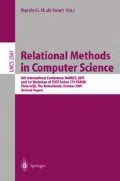Abstract
In this paper we introduce a new class of double residuated lattices. Basic properties of these algebras are given. Taking double residuated lattices as a basis, we propose a fuzzy generalisation of information relations. We also define several fuzzy information operators and show that some classes of information relations can be characterised by means of these operators.
Access this chapter
Tax calculation will be finalised at checkout
Purchases are for personal use only
Preview
Unable to display preview. Download preview PDF.
References
G. Allwein and M. Dunn (1993). “Kripke models for linear logic”. Journal of Symbolic Logic58, No 2, pp. 514–545.
Ph. Balbiani and E. Orłowska (1999). “A hierarchy of modal logics with relative accessibility relations”. Journal of Applied Non-Classical Logics 9, No 2-3, pp. 303–328, special issue in the memory of George Gargov.
K. Blount and C. Tsinakis (2001). “The structure of residuated lattices”. Preprint.
L. Farinas del Cerro and H. Prade (1986) “Rough sets, fuzzy sets and modal logic”. Fuzziness in indiscernibility and partial information. In: A. Di Nola and A. G. Ventre (eds), The Mathematics of Fuzzy Systems, Verlag TÜV Rheinland.
C. C. Chang (1958) “Algebraic analysis of many-valued logics”. Transactions of the American Mathematical Society 88, pp. 467–490.
S. Demri, E Orłowska and D. Vakarelov (1999). “Indiscernibility and complementarity relations in information systems”. In: J. Gerbrandy, M. Marx, M. de Rijke and Y. Venema (eds) JFAK. Essays Dedicated to Johan van Benthem on the Occasion of his 50th Birthday. Amsterdam University Press.
S. Demri and E Orłowska (2002). Incomplete Information: Structure, Inference, Complexity. EATCS Monographs in Theoretical Computer Science, Springer, forthcoming.
R. P. Dilworth and N. Ward (1939) “Residuated lattices”. Transactions of the American Mathematical Society 45, pp. 335–354.
I. Düntsch and E. Orłowska (2000). “Logics of complementarity in information systems”. Mathematical Logic Quarterly 46, pp. 267–288.
I. Düntsch and E. Orłowska (2000). “Beyond modalities: suficiency and mixed algebras”. In: E. Orłowska and A. Szałas (eds) Relational Methods for Computer Science Applications, Physica Verlag, Heidelberg, pp. 263–285.
I. Düntsch and E. Orłowska (2001). “Algebraic structures for qualitative reasoning”. Alfred Tarski Centenary Conference, Warsaw, Poland.
F. Esteva and L. Godo (2001) “Monoidal t-norm based logic: towards a logic for left-continuous t-norms”. Fuzzy Sets and Systems 124, pp. 271–288.
F. Esteva and L. Godo (2001). “On complete residuated many-valued logics with tnorm conjunction”. Proceedings of the 31st International Symposium on Multiple-Valued Logic, Warsaw, Poland, pp. 81–86.
P. Flondor, G. Georgescu, and A. Iorgulecu (2001). “Psedo-t-norms and pseudo-BL algebras”. Soft Computing 5, No 5, pp. 355–371.
S. Gottwald (2001). A Treatise on Many-Valued Logics, Studies in Logic and Computation 9, Research Studies Press: Baldock, Hertfordshire, England.
J. A. Gougen (1967). “L-fuzzy sets”. Journal of Mathematical Analysis and Applications 18, pp. 145–174.
P. Hajek (1998). Metamathematics of Fuzzy Logic, Kluwer, Dordrecht.
J. B. Hart, L. Rafter, and C. Tsinakis (2001). “The structure of commutative residuated lattices”. Preprint.
C. A. R. Hoare and H. Jifeng (1986). “The weakest prespecification”. Part I: Fundamenta Informaticae IX, pp. 51–84. Part II: Fundamenta Informaticae IX, pp. 217-252.
U. Höhle and U.P. Klement (eds) (1996). Non-Classical Logics and their Applications to Fuzzy Subsets, Kluwer, Dordrecht.
U. Höhle (1996). “Commutative, residuated l-monoids”. In [20], pp. 53–106.
I. Humberstone (1983). “Inaccessible words”. Notre Dame Journal of Formal Logic 24, pp. 346–352.
P. Jipsen (2001). “A Gentzen system and decidability for residuated lattices”. Preprint.
B. Konikowska (1997). “ogic for reasoning about relative similarity” Studia Logica 58, pp. 185–226.
R. K. Meyer and R. Routley (1972). “Algebraic analysis of entailment”, Logique et analyse 15, pp. 6.
E. Orłowska (1988). “Kripke models with relative accessibility and their application to inferences from incomplete information”. In: Mirkowska, G. and Rasiowa, H. (eds), Mathematical Problems in Computation Theory. Banach Center Publications 21, pp. 329–339.
E. Orłowska (ed) (1998). Incomplete Information — Rough Set Analysis, Studies in Fuzziness and Soft Computing, Springer-Verlag.
E. Orłowska (1999). “Many-valuedness and uncertainty”. Multiple-Valued Logic 4, pp. 207–227.
E. Orłowska and A. M. Radzikowska (2001). “Information relations and operators based on double residuated lattices”. In H. de Swart (ed), Proceedings of the 6th Seminar on Relational Methods in Computer Science RelMiCS’2001, pp. 185–199.
A. M. Radzikowska and E. E. Kerre (2002) “A comparative study of fuzzy rough sets”. Fuzzy Sets and Systems 126 No 2, pp. 137–155.
A. M. Radzikowska, E. E. Kerre (2002) “A general calculus of fuzzy rough sets”. Submitted.
A. M. Radzikowska and E. E. Kerre (2001). “On some classes of fuzzy information relations”. Proceedings of the 31st International Symposium on Multiple-Valued Logic, Warsaw, Poland, pp. 75–80.
A. M. Radzikowska and E. E. Kerre (2001) “Towards studying of fuzzy information relations”. To appear in Proceedings of EUSFLAT-2001, Leicester, UK.
H. Rasiowa and R. Sikorski (1970). The Mathematics of Metamathematics, Warszawa.
C. Rauszer (1974). “Semi-Boolean algebras and their applications to intuitionistic logic with dual operations”. Fundamenta Mathematicae 83, pp. 219–249.
B. Schweizer and A. Sklar (1983). Probabilistic Metric Spaces. North Holland, Amsterdam.
E. Turunen (1999) Mathematics Behind Fuzzy Logic, Springer-Verlag.
D. Vakarelov (1998). “Information systems, similarity relations and modal logics”. In [27], pp. 492–550.
Author information
Authors and Affiliations
Editor information
Editors and Affiliations
Rights and permissions
Copyright information
© 2002 Springer-Verlag Berlin Heidelberg
About this paper
Cite this paper
Orłowska, E., Radzikowska, A.M. (2002). Double Residuated Lattices and Their Applications. In: de Swart, H.C.M. (eds) Relational Methods in Computer Science. RelMiCS 2001. Lecture Notes in Computer Science, vol 2561. Springer, Berlin, Heidelberg. https://doi.org/10.1007/3-540-36280-0_12
Download citation
DOI: https://doi.org/10.1007/3-540-36280-0_12
Published:
Publisher Name: Springer, Berlin, Heidelberg
Print ISBN: 978-3-540-00315-1
Online ISBN: 978-3-540-36280-7
eBook Packages: Springer Book Archive

